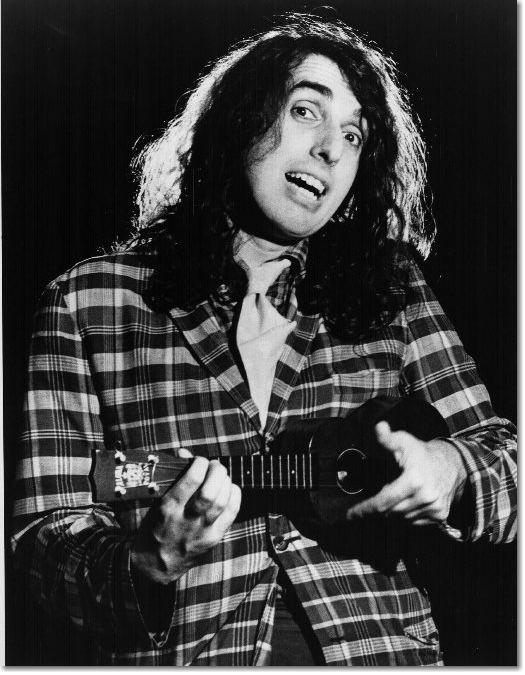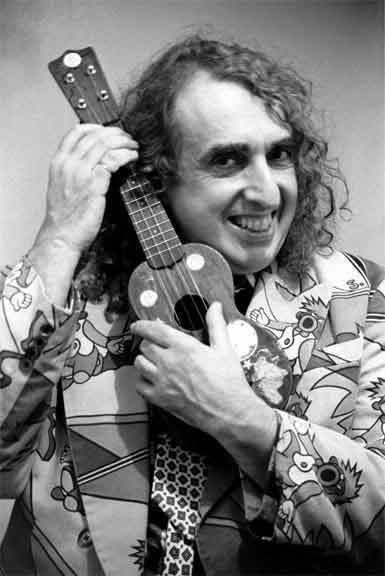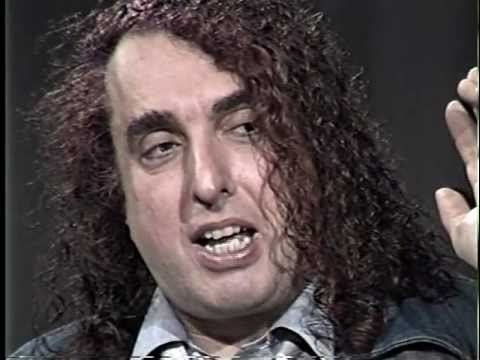Birth name Herbert Khaury Name Tiny Tim Genres Americana Role Singer | Occupation(s) Singer, musician Height 1.85 m Years active 1962–1996 | |
 | ||
Origin New York City, United States Died November 30, 1996, Hennepin County, Minnesota, United States Spouse Susan Marie Gardner (m. 1995–1996), Jan Alweiss (m. 1984–1995), Miss Vicki (m. 1969–1977) Parents Tillie Staff, Butros Khaury Similar People Miss Vicki, GG Allin, Bob Dylan, Jim Henson, Johnny Carson | ||
Tiny tim tiptoe through the tulips
Herbert Buckingham Khaury (April 12, 1932 – November 30, 1996), known professionally as Tiny Tim, was an American singer, most of the time Ukulele player, and musical archivist. He is best remembered for his cover hits "Tiptoe Through the Tulips" and "Livin' in the Sunlight, Lovin' in the Moonlight" which are sung in a high falsetto/vibrato voice.
Contents
- Tiny tim tiptoe through the tulips
- Early life
- Life and career
- Death
- Posthumous releases
- In popular culture
- References

Early life

Tiny Tim was born in Manhattan, New York City on April 12, 1932. His mother was Tillie (née Staff), a garment worker, who was the daughter of a rabbi. She had immigrated from Brest-Litovsk as a teen in 1914. Tiny's father, Butros Khaury, was a textile worker from Beirut, Lebanon who was a Maronite Christian priest.

Tiny Tim displayed musical talent at a very young age. At the age of five, his father gave him a vintage wind up Gramophone and a 78 RPM record of "Beautiful Ohio" by Henry Burr. He would sit for hours listening to the record. At the age of six, he began teaching himself guitar. By his pre-teen years, he developed a passion for records, specifically those from the 1900s through the 1930s. He began spending most of his free time at the New York Public Library, reading about the history of the phonograph industry and its first recording artists. He would research sheet music, often making photographic copies to take home to learn, a hobby he continued for his entire life.
Life and career

At eleven years of age Khaury began learning to play the violin, and later picked up the mandolin, and what would be considered his signature instrument, the ukulele, and enjoyed performing at home for his parents. During his recovery from having his appendix removed in 1945, he read the Bible, listened to music on the radio and sang along, and after that rarely left his room, except to go to school, where he was a mediocre student. After repeating his sophomore year of high school, he dropped out entirely, taking a series of menial jobs.

In a 1968 interview on The Tonight Show, he described the discovery of his ability to sing in an upper register: "I was listening to the radio and singing along; as I was singing I said 'Gee, it's strange. I can go up high as well.'" In a 1969 interview he said he was listening to Rudy Vallee sing in a falsetto, and "had something of a revelation—I never knew that I had another top register," describing it as a religious experience.

By the early 1950s, he had landed a job as a messenger at the New York office of MGM Studios, where he became ever more fascinated with the entertainment industry. He then entered a local talent show and sang "You Are My Sunshine" in his newly discovered falsetto. He started performing at dance club amateur nights under different names, such as Texarkana Tex, Judas K. Foxglove, Vernon Castle, and Emmett Swink. To stand out from the crowd of performers he wore wild clothing and, after seeing an old poster of a long-haired Rudolph Valentino, grew his own hair out to shoulder length, and wore pasty white facial makeup. His mother did not understand Herbert's change in appearance and was intending to take her son, now in his twenties, to see a psychiatrist at Bellvue Hospital, until his father stepped in.

In 1959, he dropped all his other stage names, and performed as "Larry Love, the Singing Canary" at Hubert's Museum and Live Flea Circus in New York City's Times Square. While performing here, he signed with a manager who sent him out on auditions through the Greenwich Village section of New York, where he played the ukulele and sang in his falsetto voice the song which would become his signature, "Tiptoe Through the Tulips", and performed unpaid amateur gigs.

Film critic Roger Ebert wrote:
I first saw Tiny Tim very early in his career, in Greenwich Village in the winter of 1962–63. There was a convention of college newspaper editors, and a few of us – I remember Jeff Greenfield coming along – went to the Black Pussycat and found ourselves being entertained by a man the likes of whom we'd not seen before. He was already locally popular.
In 1963 he landed his first paying gig at Page 3, a gay and lesbian club in Greenwich Village, playing 6 hours a night, 6 nights a week, for $96 per month. He performed for the next two years as "Dary Dover", and after that, "Sir Timothy Timms". After being booked to follow a "midget" (sic) act, his manager, George King billed the 6' 1" (185 cm) Khaury using the antiphrasic stage name "Tiny Tim".
Tiny Tim appeared in Jack Smith's Normal Love (1963), as well as the independent feature film You Are What You Eat (1968) in which he sang the Ronettes song "Be My Baby" in his falsetto range; also featured was a rendition of Sonny and Cher's "I Got You Babe", with Tim singing the Cher parts in his falsetto voice, along with Eleanor Barooshian singing Sonny Bono's baritone part. These tracks were recorded with musicians who went on to be in The Band. The "I Got You Babe" performance led to a booking on the Rowan and Martin's Laugh-In, an American television comedy-variety show. Co-host Dan Rowan announced that Laugh-In believed in showcasing new talent, and introduced Tiny Tim. The singer entered carrying a shopping bag, pulled his soprano ukulele from it, and sang a medley of "A Tisket A Tasket" and "On The Good Ship Lollipop" as an apparently dumbfounded co-host Dick Martin watched. In his third performance on Laugh-In, Tiny Tim entered blowing kisses, preceded by an elaborate procession of the cast and, after a short interview, he sang "Tiptoe Through the Tulips".
In 1968, his first album God Bless Tiny Tim was released. It contained an orchestrated version of "Tiptoe Through the Tulips", which became a hit after being released as a single. For All My Little Friends (1969) was a collection of children's songs and was nominated for a Grammy Award.
On October 7, 1969, Tiny Tim was able to take the ice before a charity hockey event at the hockey shrine Maple Leaf Gardens, with his beloved Toronto Maple Leafs, his favourite pro sports team. Wearing the skates and jersey of future hall of fame member (as a coach), Pat Quinn, Mike Walton and Jim McKenny helped him skate on the ice, his very first time trying to skate. He was quoted as saying "What a thrill! Just being on the ice was great!”. Reacting well to his inability to skate on his own, he said “I was always athletic spiritually, not physically".
Tiny Tim was married three times and had one daughter from his first marriage to Victoria Budinger (also known as "Miss Vicki"). Tiny Tim married Miss Vicki on The Tonight Show Starring Johnny Carson on December 17, 1969, with 40 million people watching. Shortly after their marriage, Miss Vicki discovered she was pregnant, but the child was stillborn five months later. Khaury buried the child with a headstone that read "It". Daughter Tulip Victoria was born in 1971. Soon after, Vicki met male model John Carmen at a television shoot her husband was doing, and began a relationship with Carmen, and they were often seen together in night clubs. According to Khaury's third wife, Sue, "Miss Vicki" was physically abusive toward her husband. Tiny Tim and Miss Vicki separated for good in 1974, and they divorced three years later in 1977. He married Jan Alweiss ("Miss Jan") in 1984, and Susan Marie Gardner ("Miss Sue") in 1995. When Tiny Tim first became well-known to the American public, pundits and journalists debated whether this character being presented was just an orchestrated act or the real thing. "It quickly became clear that he was genuine," however, and that he could probably be best described as "a lonely outcast intoxicated by fame" and "a romantic" always in pursuit of his ideal dream.
After his career highlights, Tiny Tim's television appearances dwindled, and his popularity began to wane. He continued to play around the United States, making several lucrative appearances in Las Vegas. When his recording contract ended with Reprise, he founded his own record label and humorously named it Vic Tim Records, as a pun on the combination of his wife's name with that of his own. He performed with the American alternative rock band Camper Van Beethoven in 1986. In the 1990s, he released several albums, including Rock (1993), I Love Me (1993), and Girl (1996).
Tiny Tim was published in 1976 by Playboy Press, a biography by Harry Stein.
Death
On September 28, 1996, Tiny suffered a heart attack just as he began singing at a ukulele festival at the Montague Grange Hall in Montague, Massachusetts (this hall is often confused in accounts of the incident with the nearby Montague Bookmill, at which he had recorded a video interview earlier that same day). He was hospitalized at the nearby Franklin County Medical Center in Greenfield for approximately three weeks before being discharged with strong admonitions not to perform again because of his health, weight, and the dietary needs for his diabetic and heart conditions. Nevertheless, he ignored the advice.
On November 30, 1996, he was playing at a gala benefit hosted by the Women's Club of Minneapolis. He had let his third wife ("Miss Sue") know before the performance that he was not feeling well, but did not want to disappoint the fans. By the end of his performance, most of the audience had left. While performing his last number of the evening, he suffered another heart attack on stage in the middle of a rendition of his hit, "Tiptoe Through the Tulips". His wife asked him if he was feeling all right, and he said he was not; she was helping him back to their table when he collapsed, and never regained consciousness. EMTs performed on-site CPR, and transported him to Hennepin County Medical Center, where, after many revival attempts at the hospital, Tiny Tim was pronounced dead nearly an hour later. His remains are entombed in a mausoleum in Lakewood Cemetery in Minneapolis.
Posthumous releases
In 2000, the Rhino Handmade label released the posthumous Tiny Tim Live at the Royal Albert Hall. This recording had been made in 1968 at the height of Tiny Tim's fame, but Reprise Records never released it. The limited-numbered CD sold out and was reissued on Rhino's regular label. In 2009, the Collector's Choice label released I've Never Seen a Straight Banana, produced and recorded by Richard Barone in 1976. The album was a collection of rare recordings of some of Tiny Tim's favorite songs from 1878 through the 1930s, along with some of his own compositions.
In 2009, it was reported that Justin Martell was preparing a biography of Tiny Tim, released in 2016 under the title Eternal Troubadour: The Improbable Life of Tiny Tim. Martell is called one of America's "foremost experts" on Tiny Tim; he contributed liner notes to I've Never Seen a Straight Banana and the 2011 Tiny Tim compilation LP Tiny Tim: Lost & Found 1963–1974 (Rare & Unreleased), released on Secret Seven Records.
In 2013, a biography of Tiny Tim was released in two editions. Tiny Tim: Tiptoe Through A Lifetime was released July 16, 2013, and is by Lowell Tarling (author) and Martin Sharp (illustrator). Ship To Shore PhonoCo followed up Lost & Found Vol 1 with a Vol 2 featuring Tiny Tim's 1974 live recording of "(Nobody Else Can Love Me Like) My Old Tomato Can" on a limited edition wax cylinder.
In 2016, Ship To Shore PhonoCo released Tiny Tim's America, a collection of demos recorded by Tiny Tim in 1974 and finished in 2015 with overdubs overseen by producer Richard Barone and Tiny Tim's cousin Eddie Rabin. The album was subtitled "Rare Moments Vol. 2" and presented as a spiritual sequel to 2009's I've Never Seen A Straight Banana: Rare Moments Vol 1.
In popular culture
His cover of "Livin' in the Sunlight, Lovin' in the Moonlight" was featured in the "Help Wanted" segment of the first episode of the cartoon SpongeBob SquarePants. His rendition of "Tiptoe Through the Tulips" was a main part of the 2011 horror film Insidious and also used as a bass track in "The Amazing Adventures of DJ Yoda" in the mix Tip Toe. In Ursula Dubosarsky's trilogy for children, The Strange Adventures of Isador Brown, the hero Isador's Daddy has long red hair and plays the ukulele, and is, according to the author, based on and inspired by Tiny Tim.
In the 1992 Roxette song "How Do You Do!", singer Per Gessle mentions Tiny Tim in the lyrics: "I love your blue-eyed voice, like Tiny Tim shines thru".
